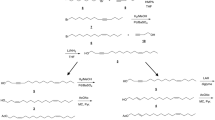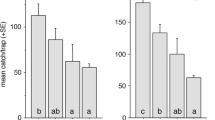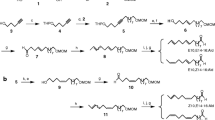Abstract
In field experiments traps were baited with live females or with a two-, four-, or eight-component blend of the 16-carbon aldehydes previously identified as components of the sex pheromone emitted by femaleManduca sexta moths. The blends were formulated on rubber septa. Traps baited with a blend of all eight aldehydes captured moreM. sexta males than any other treatment. Septa loaded with 600 μg of the eight-component blend were attractive to males for about seven days in the field. Septa loaded with the eight-component blend and stored in a refrigerator at 4°C for a year released the conjugated diene and triene aldehydes at the same rate as freshly prepared septa and were equally attractive in the field.
Similar content being viewed by others
References
Baumhover, A.H. 1985.Manduca sexta, pp. 387–400,in P. Singh, and R.F. Moore (eds.). Handbook of Insect Rearing, Vol. 2, Elsevier, Amsterdam.
Baumhover, A.H., Cantelo, W.W., Hobgood, J.M., Jr., Knott, C.M., andLam, J.J., Jr. 1977. An improved method for mass rearing the tobacco hornworm. US Department of Agriculture, Agricultural Research Service, ARS-S-167, 13 pp.
Christensen, T.A., Hildebrand, J.G., Tumlinson, J.H., andDoolittle, R.E. 1989. Sex pheromone blend ofManduca sexta: Responses of central olfactory interneurons to antennal stimulation in male moths.Arch. Insect Biochem. Physiol. 10:281–291.
Dollittle, R.E., andSolomon, J.D. 1986. Stereoselective synthesis of (Z,E)-3,5-tetradecadienyl acetate; Sex attractant for carpenterworm moth,Prionoxystus robiniae (Perk) (Lepidoptera: Cossidae) and effect of isomers and monounsaturated acetates on its attractiveness.J. Chem. Ecol. 12:619–633.
Doolittle, R.E., Brabham, A., andTumlinson, J.H. 1990. Sex pheromone ofManduca sexta (L.): Stereoselective synthesis of (10E, 12E, 14Z)-10,12,14-hexadecatrienal and isomers.J. Chem. Ecol. 16:1131–1153.
Duncan, D.B. 1955. Multiple range and multiple F tests.Biometrics 11:1–42.
Hartstack, A.W., Witz, J.A., andBuck, D.R. 1979. Moth traps for the tobacco budworm.J. Econ. Entomol. 72:519–522.
Heath, R.R., andTumlinson, J.H. 1986. Correlation of retention times on liquid crystal column with reported vapor pressures and half-lives of compounds used in pheromone formulations.J. Chem. Ecol. 12:2081–2088.
Heath, R.R., Tumlinson, J.H., Doolittle, R.E., andDuncan, J.H. 1977. Analytical and preparative separation of geometrical isomers by high efficiency silver nitrate liquid chromatography.J. Chromatogr. Sci. 15:10–13.
Heath, R.R., Jordan, J.R., Sonnet, P.E., andTumlinson, J.H. 1979. Potential for the separation of insect pheromones by gas chromatography on columns coated with cholesteryl cinnamate, a liquid-crystal phase.J. HRC&CC 2:712–714.
Heath, R.R., Jordan, J.R., andSonnet, P.E. 1981. Effect of film thickness and supercooling on the performance of cholesteryl cinnamate liquid crystal capillary columns.J. HRC&CC 4:328–332.
Heath, R.R., Teal, P.E.A., Tumlinson, J.H., andMengelkoch, L.J. 1986. Prediction of release ratios of multicomponent pheromones from rubber septa.J. Chem. Ecol. 12:2133–2143.
Heath, R.R., Coffelt, J.A., Proshold, E.I., Jansson, R.K., andSonnet, P.E. 1991. Sex pheromone ofCylas formicarius: History and implications of chemistry in weevil management, pp. 79–96,in R.K. Jansson and K.V. Raman (eds.). Sweet Potato Pest Management, a Global Perspective. Westview Press, Boulder, Colorado.
Kaissling, K.E., Hildebrand, J.G., andTumlinson, J.H. 1989. Pheromone receptor cells in the male mothManduca sexta.Arch. Insect Biochem. Physiol. 10:273–279.
Madden, H.H., andChamberlin, S.E. 1945. Biology of the tobacco hornworm in the southern cigar-tobacco district. USDA Technical Bulletin No. 896, 51 pp.
Scholtzhauer, S.D., andLittel, R.C. 1987. SAS system for elementary statistical analysis. SAS Institute, Inc., Cary, North Carolina, 416 pp.
Starrat, A.N., Dahm, K.H., Allen, N., Hildebrand, J.G., Payne, T.L., andRöller, H. 1979. Bombykal, a sex pheromone of the sphinx moth,Manduca sexta.Z. Naturforsch 34:9–12.
Tumlinson, J.H., Brennan, M.M., Dollittle, R.E., Mitchell, E.R., Brabham, A., Mazomenos, B.E., Baumhover, A., andJackson, D.M. 1989. Identification of a pheromone blend attractive toManduca sexta (L.) males in a wind tunnel.Arch. Insect Biochem. Physiol. 10:255–271.
Zweifel, G., andBacklund, S.J. 1978. Synthesis of 1,4-disubstituted (E,Z)-1,3-dienes from lithium dicyclohexyl (trans-1-alkenyl) (1-alkynyl) borates.J. Organomet. Chem. 156:159–170.
Author information
Authors and Affiliations
Rights and permissions
About this article
Cite this article
Tumlinson, J.H., Mitchell, E.R., Doolittle, R.E. et al. Field tests of syntheticManduca sexta sex pheromone. J Chem Ecol 20, 579–591 (1994). https://doi.org/10.1007/BF02059599
Received:
Accepted:
Issue Date:
DOI: https://doi.org/10.1007/BF02059599




